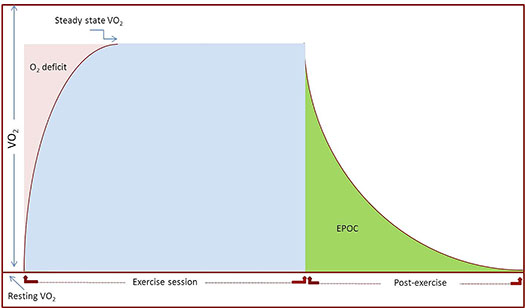What Kind of Exercise Raises Our Metabolism?
Our cells consume extra oxygen (and burns extra calories) during a workout. This elevated oxygen consumption can continue after a workout because the cells are busy restoring and building tissue in order to prepare our body for the next workout. This phenomenon is known as excess post exersice oxygen consumption or EPOC. EPOC was first noted in the 1920’s but has been studied extensively since the 1980’s. Though the studies regarding how long EPOC lasts are conflicting due to different measurement methods, types of exercise, duration and mode; we do know that exercise intensity is the strongest factor affecting EPOC. The harder we train, the greater the afterburn
Study on Aerobic training in a metabolic chamber
Since testing in a metabolic chamber is the most accurate way of measuring metabolism, I’d like to site a study, Knab et al, (2011) published in Medicine and Science in Sports and Exercise. A metabolic chamber is a small room where subjects can live while scientists measure precisely how they eat, sleep and exercise while also tracking how oxygen is consumed in the vacuum. Since other methods of measuring metabolism are not as accurate and since the subjects can not lie about how they eat, move or sleep, this study has great appeal.
According to this study done on 25 year old men, a 45 minute workout on a cycle ergometer had an average energy cost of 519 kilocalories. EPOC was elevated for 14 hours afterwards–an increase of 190 kcal compared with the control group of those who rested.
Comparing high intensity resistance training to traditional resistance training
Another study on how traditional resistance training compared to high intensity resistance training, Paeli et al, (2012) published in Journal of Translational Medicine, tested men (aged 24-32). The first group used traditional resistance training methods which consisted of 4 sets of 8-12 repetitions to failure (70%-75% of their 1 rep max) with 1 minute rest between sets for single joint exercises and 2 minutes rest for multiple joint exercises. The training lasted 62 minutes including a 10 minute warm up on the treadmill.
The high intensity training group lifted to failure a weight comparable to the subject’s 6-RM (meaning subjects could do 6 reps but not 7 or more). After 20 seconds of rest they lifted the same weight to failure a third time (1-2 reps). They rested for 2.3 minutes then repeated the entire regimen a second and third time. The training session lasted approximately 32 minutes, including a 10 minute warm up on a treadmill.
Ater a 22 hour period, the subjects were tested. The traditional resistance training group had an energy expenditure that was 5% (99 kcal) greater than their resting values. The higher intensity group’s energy expenditure was 23% greater (452 kcal).
According to these studies EPOC is elevated after many types of workouts but mostly for high intensity resistance training, probably because that produces the most wear and tear on the body, thereby requiring more recovery.
Also keep in mind that while intense training increases the metabolism, starving oneself and over exercising can decrease the metabolism. The subjects in the these studies were also given extra food to make up for the extra calories they burned. For more information on how not eating enough while exercising too much can hurt the metabolism, read this article:
Dieting Too Much? You Could Be Hurting More Than Your Metabolism
For more information on burning calories, read this article:
How Many Calories Did I Just Burn?
This month, I will be doing a workshop on nutrition that will cover nutrition and diet recommendations for athletic performance and fat loss. Learn which carbohydrates impact glucose levels, which proteins and fats we should be eating, and how to properly calculate your ideal caloric intake/output. All of the information to be shared are based on the latest studies and most up to date expert advice.
For more information on this workshop, click this link:
NUTRITION WORKSHOP: The Truth About Calories:
Carbohydrates and Nutrition for Fitness
